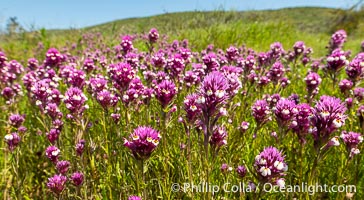
Purple owls clover, Rancho La Costa, Carlsbad.
Location: Rancho La Costa, Carlsbad, California
Image ID: 39362
Location: Rancho La Costa, Carlsbad, California
Image ID: 39362
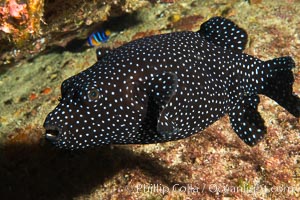
Guineafowl puffer fish, black phase.
Location: Isla San Diego, Baja California, Mexico
Image ID: 33541
Location: Isla San Diego, Baja California, Mexico
Image ID: 33541
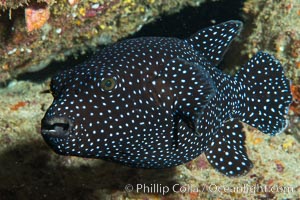
Guineafowl puffer fish, black phase.
Location: Isla San Diego, Baja California, Mexico
Image ID: 33542
Location: Isla San Diego, Baja California, Mexico
Image ID: 33542
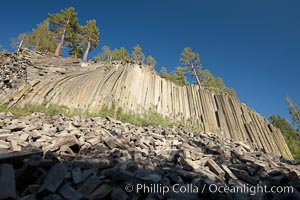
Devil's Postpile, a spectacular example of columnar basalt. Once molten and under great pressure underground, the lava that makes up Devil's Postpile cooled evenly and slowly, contracting and fracturing into polygonal-sided columns. The age of the formation is estimated between 100 and 700 thousand years old. Sometime after the basalt columns formed, a glacier passed over the formation, cutting and polishing the tops of the columns. The columns have from three to seven sides, varying because of differences in how quickly portions of the lava cooled.
Location: Devils Postpile National Monument, California
Image ID: 23281
Location: Devils Postpile National Monument, California
Image ID: 23281
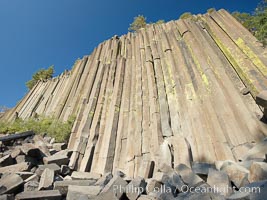
Devil's Postpile, a spectacular example of columnar basalt. Once molten and under great pressure underground, the lava that makes up Devil's Postpile cooled evenly and slowly, contracting and fracturing into polygonal-sided columns. The age of the formation is estimated between 100 and 700 thousand years old. Sometime after the basalt columns formed, a glacier passed over the formation, cutting and polishing the tops of the columns. The columns have from three to seven sides, varying because of differences in how quickly portions of the lava cooled.
Location: Devils Postpile National Monument, California
Image ID: 23282
Location: Devils Postpile National Monument, California
Image ID: 23282
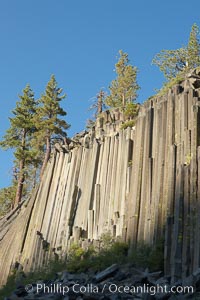
Devil's Postpile, a spectacular example of columnar basalt. Once molten and under great pressure underground, the lava that makes up Devil's Postpile cooled evenly and slowly, contracting and fracturing into polygonal-sided columns. The age of the formation is estimated between 100 and 700 thousand years old. Sometime after the basalt columns formed, a glacier passed over the formation, cutting and polishing the tops of the columns. The columns have from three to seven sides, varying because of differences in how quickly portions of the lava cooled.
Location: Devils Postpile National Monument, California
Image ID: 23283
Location: Devils Postpile National Monument, California
Image ID: 23283
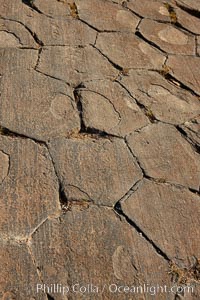
Devil's Postpile, a spectacular example of columnar basalt. Once molten and under great pressure underground, the lava that makes up Devil's Postpile cooled evenly and slowly, contracting and fracturing into polygonal-sided columns. The age of the formation is estimated between 100 and 700 thousand years old. Sometime after the basalt columns formed, a glacier passed over the formation, cutting and polishing the tops of the columns. The columns have from three to seven sides, varying because of differences in how quickly portions of the lava cooled.
Location: Devils Postpile National Monument, California
Image ID: 23284
Location: Devils Postpile National Monument, California
Image ID: 23284
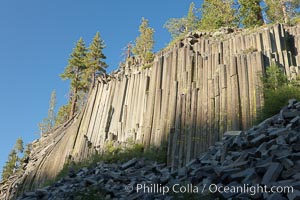
Devil's Postpile, a spectacular example of columnar basalt. Once molten and under great pressure underground, the lava that makes up Devil's Postpile cooled evenly and slowly, contracting and fracturing into polygonal-sided columns. The age of the formation is estimated between 100 and 700 thousand years old. Sometime after the basalt columns formed, a glacier passed over the formation, cutting and polishing the tops of the columns. The columns have from three to seven sides, varying because of differences in how quickly portions of the lava cooled.
Location: Devils Postpile National Monument, California
Image ID: 23286
Location: Devils Postpile National Monument, California
Image ID: 23286
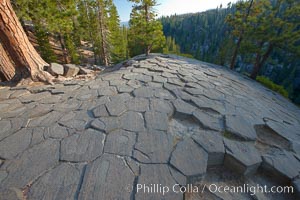
Devil's Postpile, a spectacular example of columnar basalt. Once molten and under great pressure underground, the lava that makes up Devil's Postpile cooled evenly and slowly, contracting and fracturing into polygonal-sided columns. The age of the formation is estimated between 100 and 700 thousand years old. Sometime after the basalt columns formed, a glacier passed over the formation, cutting and polishing the tops of the columns. The columns have from three to seven sides, varying because of differences in how quickly portions of the lava cooled.
Location: Devils Postpile National Monument, California
Image ID: 23287
Location: Devils Postpile National Monument, California
Image ID: 23287
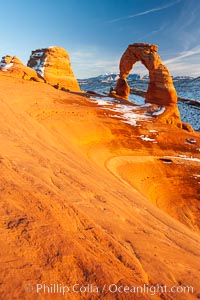
Delicate Arch, dusted with snow, at sunset, with the snow-covered La Sal mountains in the distance. Delicate Arch stands 45 feet high, with a span of 33 feet, atop of bowl of slickrock sandstone.
Location: Delicate Arch, Arches National Park, Utah
Image ID: 18106
Location: Delicate Arch, Arches National Park, Utah
Image ID: 18106
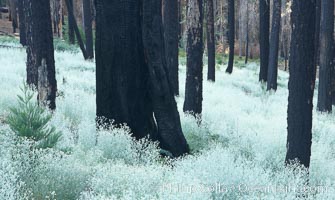
Lowlying plants grow where a forest fire has cleared the forest floor of debris, allowing seeds of small shrubs and trees to take root. The charred and burnt trees remain behind, some of them still alive in spite of their blackened appearance.
Location: Mariposa Grove, Yosemite National Park, California
Image ID: 23262
Location: Mariposa Grove, Yosemite National Park, California
Image ID: 23262
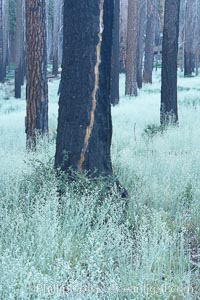
Lowlying plants grow where a forest fire has cleared the forest floor of debris, allowing seeds of small shrubs and trees to take root. The charred and burnt trees remain behind, some of them still alive in spite of their blackened appearance.
Location: Mariposa Grove, Yosemite National Park, California
Image ID: 23277
Location: Mariposa Grove, Yosemite National Park, California
Image ID: 23277
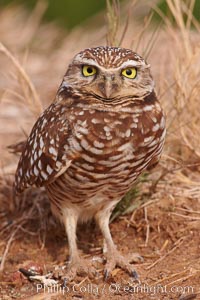
Burrowing owl (Western North American race hypugaea). This 10-inch-tall burrowing owl is standing besides its burrow. These burrows are usually created by squirrels, prairie dogs, or other rodents and even turtles, and only rarely dug by the owl itself.
Species: Burrowing owl, Athene cunicularia, Athene cunicularia hypugaea
Location: Salton Sea, Imperial County, California
Image ID: 22477
Species: Burrowing owl, Athene cunicularia, Athene cunicularia hypugaea
Location: Salton Sea, Imperial County, California
Image ID: 22477
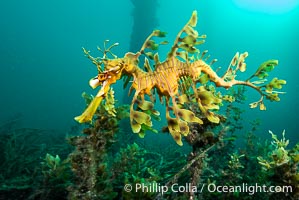
The leafy seadragon (Phycodurus eques) is found on the southern and western coasts of Australia. Its extravagent appendages serve only for camoflage, since it has a nearly-invisible dorsal fin that propels it slowly through the water. The leafy sea dragon is the marine emblem of South Australia.
Species: Leafy seadragon, Phycodurus eques
Location: Rapid Bay Jetty, South Australia
Image ID: 39133
Species: Leafy seadragon, Phycodurus eques
Location: Rapid Bay Jetty, South Australia
Image ID: 39133
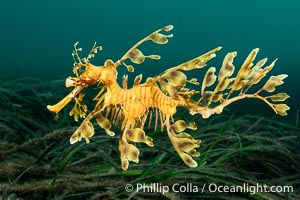
The leafy seadragon (Phycodurus eques) is found on the southern and western coasts of Australia. Its extravagent appendages serve only for camoflage, since it has a nearly-invisible dorsal fin that propels it slowly through the water. The leafy sea dragon is the marine emblem of South Australia.
Species: Leafy seadragon, Phycodurus eques
Location: Rapid Bay Jetty, South Australia
Image ID: 39136
Species: Leafy seadragon, Phycodurus eques
Location: Rapid Bay Jetty, South Australia
Image ID: 39136
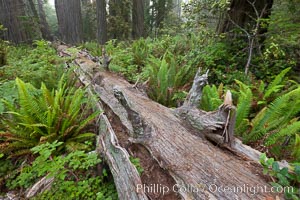
Fallen coast redwood tree. This tree will slowly decompose, providing a substrate and nutrition for new plants to grow and structure for small animals to use. Nurse log.
Species: California redwood, Coast redwood, Giant redwood, Sequoia sempervirens
Location: Redwood National Park, California
Image ID: 25803
Species: California redwood, Coast redwood, Giant redwood, Sequoia sempervirens
Location: Redwood National Park, California
Image ID: 25803
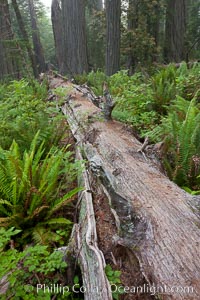
Fallen coast redwood tree. This tree will slowly decompose, providing a substrate and nutrition for new plants to grow and structure for small animals to use. Nurse log.
Species: California redwood, Coast redwood, Giant redwood, Sequoia sempervirens
Location: Redwood National Park, California
Image ID: 25820
Species: California redwood, Coast redwood, Giant redwood, Sequoia sempervirens
Location: Redwood National Park, California
Image ID: 25820
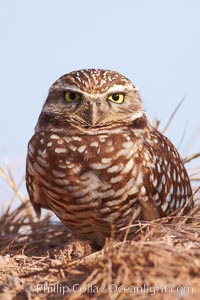
Burrowing owl (Western North American race hypugaea). This 10-inch-tall burrowing owl is standing besides its burrow. These burrows are usually created by squirrels, prairie dogs, or other rodents and even turtles, and only rarely dug by the owl itself.
Species: Burrowing owl, Athene cunicularia, Athene cunicularia hypugaea
Location: Salton Sea, Imperial County, California
Image ID: 22478
Species: Burrowing owl, Athene cunicularia, Athene cunicularia hypugaea
Location: Salton Sea, Imperial County, California
Image ID: 22478
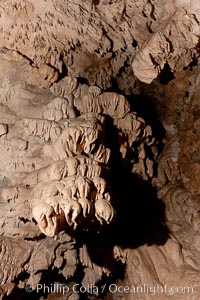
Limestone and marble underground formations in Oregon Caves National Monument. Eons of acidified groundwater have slowly etched away at marble, creating the extensive and intricate cave formations in Oregon Caves National Monument.
Location: Oregon Caves National Monument
Image ID: 25861
Location: Oregon Caves National Monument
Image ID: 25861
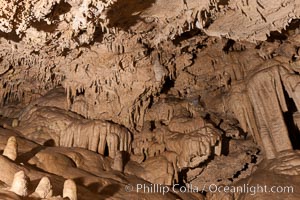
Limestone and marble underground formations in Oregon Caves National Monument. Eons of acidified groundwater have slowly etched away at marble, creating the extensive and intricate cave formations in Oregon Caves National Monument.
Location: Oregon Caves National Monument
Image ID: 25862
Location: Oregon Caves National Monument
Image ID: 25862
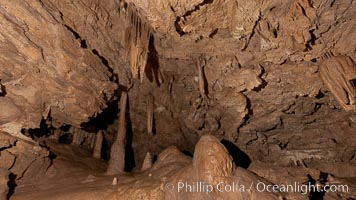
Limestone and marble underground formations, Miller's Chapel grotto in Oregon Caves National Monument. Eons of acidified groundwater have slowly etched away at marble, creating the extensive and intricate cave formations in Oregon Caves National Monument.
Location: Oregon Caves National Monument
Image ID: 25863
Location: Oregon Caves National Monument
Image ID: 25863
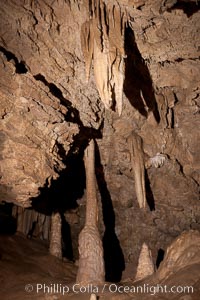
Limestone and marble underground formations, Miller's Chapel grotto in Oregon Caves National Monument. Eons of acidified groundwater have slowly etched away at marble, creating the extensive and intricate cave formations in Oregon Caves National Monument.
Location: Oregon Caves National Monument
Image ID: 25864
Location: Oregon Caves National Monument
Image ID: 25864
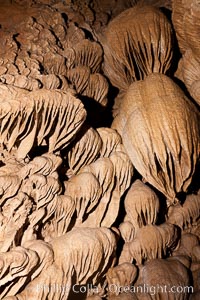
Paradise Lost formation in Oregon Caves National Monument. Eons of acidified groundwater have slowly etched away at marble, creating the extensive and intricate cave formations in Oregon Caves National Monument.
Location: Oregon Caves National Monument
Image ID: 25865
Location: Oregon Caves National Monument
Image ID: 25865
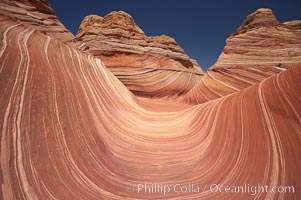
The Wave. The main corridor of the Wave, a famous and curiously shaped sandstone bowl.
Location: North Coyote Buttes, Paria Canyon-Vermilion Cliffs Wilderness, Arizona
Image ID: 20732
Location: North Coyote Buttes, Paria Canyon-Vermilion Cliffs Wilderness, Arizona
Image ID: 20732
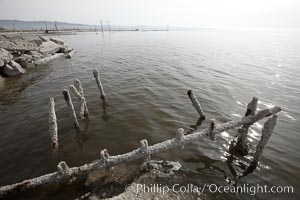
Bombay Beach, lies alongside and below the flood level of the Salton Sea, so that it floods occasionally when the Salton Sea rises. A part of Bombay Beach is composed of derelict old trailer homes, shacks and wharfs, slowly sinking in the mud and salt.
Location: Salton Sea, Imperial County, California
Image ID: 22487
Location: Salton Sea, Imperial County, California
Image ID: 22487
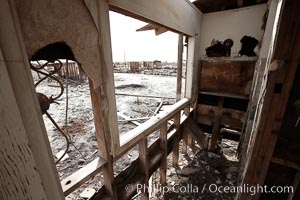
Bombay Beach, lies alongside and below the flood level of the Salton Sea, so that it floods occasionally when the Salton Sea rises. A part of Bombay Beach is composed of derelict old trailer homes, shacks and wharfs, slowly sinking in the mud and salt.
Location: Salton Sea, Imperial County, California
Image ID: 22488
Location: Salton Sea, Imperial County, California
Image ID: 22488
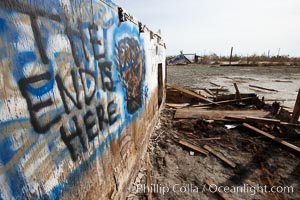
Bombay Beach, lies alongside and below the flood level of the Salton Sea, so that it floods occasionally when the Salton Sea rises. A part of Bombay Beach is composed of derelict old trailer homes, shacks and wharfs, slowly sinking in the mud and salt.
Location: Salton Sea, Imperial County, California
Image ID: 22489
Location: Salton Sea, Imperial County, California
Image ID: 22489
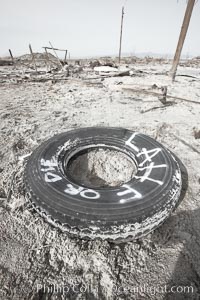
Bombay Beach, lies alongside and below the flood level of the Salton Sea, so that it floods occasionally when the Salton Sea rises. A part of Bombay Beach is composed of derelict old trailer homes, shacks and wharfs, slowly sinking in the mud and salt.
Location: Salton Sea, Imperial County, California
Image ID: 22490
Location: Salton Sea, Imperial County, California
Image ID: 22490
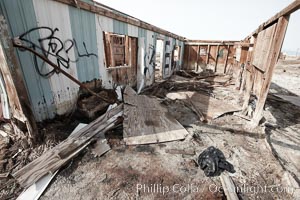
Bombay Beach, lies alongside and below the flood level of the Salton Sea, so that it floods occasionally when the Salton Sea rises. A part of Bombay Beach is composed of derelict old trailer homes, shacks and wharfs, slowly sinking in the mud and salt.
Location: Salton Sea, Imperial County, California
Image ID: 22491
Location: Salton Sea, Imperial County, California
Image ID: 22491
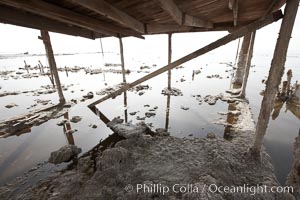
Bombay Beach, lies alongside and below the flood level of the Salton Sea, so that it floods occasionally when the Salton Sea rises. A part of Bombay Beach is composed of derelict old trailer homes, shacks and wharfs, slowly sinking in the mud and salt.
Location: Salton Sea, Imperial County, California
Image ID: 22492
Location: Salton Sea, Imperial County, California
Image ID: 22492